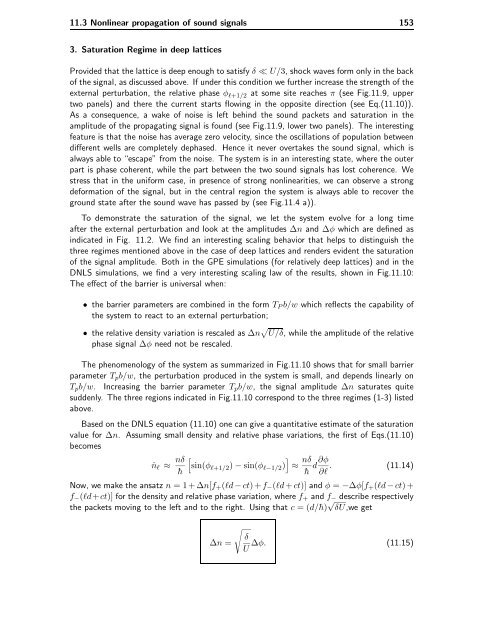Bose-Einstein Condensates in Rotating Traps and Optical ... - BEC
Bose-Einstein Condensates in Rotating Traps and Optical ... - BEC
Bose-Einstein Condensates in Rotating Traps and Optical ... - BEC
Create successful ePaper yourself
Turn your PDF publications into a flip-book with our unique Google optimized e-Paper software.
11.3 Nonl<strong>in</strong>ear propagation of sound signals 153<br />
3. Saturation Regime <strong>in</strong> deep lattices<br />
Provided that the lattice is deep enough to satisfy δ ≪ U/3, shock waves form only <strong>in</strong> the back<br />
of the signal, as discussed above. If under this condition we further <strong>in</strong>crease the strength of the<br />
external perturbation, the relative phase φℓ+1/2 at some site reaches π (see Fig.11.9, upper<br />
two panels) <strong>and</strong> there the current starts flow<strong>in</strong>g <strong>in</strong> the opposite direction (see Eq.(11.10)).<br />
As a consequence, a wake of noise is left beh<strong>in</strong>d the sound packets <strong>and</strong> saturation <strong>in</strong> the<br />
amplitude of the propagat<strong>in</strong>g signal is found (see Fig.11.9, lower two panels). The <strong>in</strong>terest<strong>in</strong>g<br />
feature is that the noise has average zero velocity, s<strong>in</strong>ce the oscillations of population between<br />
different wells are completely dephased. Hence it never overtakes the sound signal, which is<br />
always able to “escape” from the noise. The system is <strong>in</strong> an <strong>in</strong>terest<strong>in</strong>g state, where the outer<br />
part is phase coherent, while the part between the two sound signals has lost coherence. We<br />
stress that <strong>in</strong> the uniform case, <strong>in</strong> presence of strong nonl<strong>in</strong>earities, we can observe a strong<br />
deformation of the signal, but <strong>in</strong> the central region the system is always able to recover the<br />
ground state after the sound wave has passed by (see Fig.11.4 a)).<br />
To demonstrate the saturation of the signal, we let the system evolve for a long time<br />
after the external perturbation <strong>and</strong> look at the amplitudes ∆n <strong>and</strong> ∆φ which are def<strong>in</strong>ed as<br />
<strong>in</strong>dicated <strong>in</strong> Fig. 11.2. We f<strong>in</strong>d an <strong>in</strong>terest<strong>in</strong>g scal<strong>in</strong>g behavior that helps to dist<strong>in</strong>guish the<br />
three regimes mentioned above <strong>in</strong> the case of deep lattices <strong>and</strong> renders evident the saturation<br />
of the signal amplitude. Both <strong>in</strong> the GPE simulations (for relatively deep lattices) <strong>and</strong> <strong>in</strong> the<br />
DNLS simulations, we f<strong>in</strong>d a very <strong>in</strong>terest<strong>in</strong>g scal<strong>in</strong>g law of the results, shown <strong>in</strong> Fig.11.10:<br />
The effect of the barrier is universal when:<br />
• the barrier parameters are comb<strong>in</strong>ed <strong>in</strong> the form TP b/w which reflects the capability of<br />
the system to react to an external perturbation;<br />
• the relative density variation is rescaled as ∆n U/δ, while the amplitude of the relative<br />
phase signal ∆φ need not be rescaled.<br />
The phenomenology of the system as summarized <strong>in</strong> Fig.11.10 shows that for small barrier<br />
parameter Tpb/w, the perturbation produced <strong>in</strong> the system is small, <strong>and</strong> depends l<strong>in</strong>early on<br />
Tpb/w. Increas<strong>in</strong>g the barrier parameter Tpb/w, the signal amplitude ∆n saturates quite<br />
suddenly. The three regions <strong>in</strong>dicated <strong>in</strong> Fig.11.10 correspond to the three regimes (1-3) listed<br />
above.<br />
Based on the DNLS equation (11.10) one can give a quantitative estimate of the saturation<br />
value for ∆n. Assum<strong>in</strong>g small density <strong>and</strong> relative phase variations, the first of Eqs.(11.10)<br />
becomes<br />
˙nℓ ≈ nδ<br />
¯h<br />
<br />
<br />
s<strong>in</strong>(φℓ+1/2) − s<strong>in</strong>(φℓ−1/2) ≈ nδ<br />
¯h d∂φ<br />
∂ℓ<br />
. (11.14)<br />
Now, we make the ansatz n =1+∆n[f+(ℓd − ct)+f−(ℓd + ct)] <strong>and</strong> φ = −∆φ[f+(ℓd − ct)+<br />
f−(ℓd+ct)] for the density <strong>and</strong> relative phase variation, where f+ <strong>and</strong> f− describe respectively<br />
the packets mov<strong>in</strong>g to the left <strong>and</strong> to the right. Us<strong>in</strong>g that c =(d/¯h) √ δU,we get<br />
<br />
∆n =<br />
δ<br />
∆φ.<br />
U<br />
(11.15)




